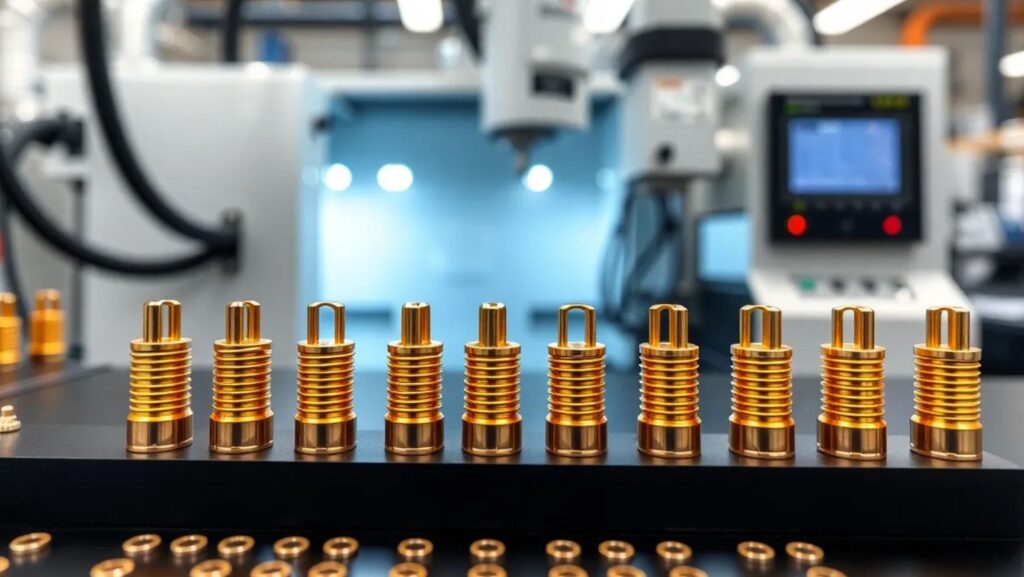How Are Pogo Pins Made? Step-by-Step Manufacturing Process, Materials, and Quality Control

Pogo pins are spring-loaded electrical connectors that power countless devices, from smartphones to medical equipment. These tiny components create reliable connections in tight spaces, playing a crucial role in modern electronics. The manufacturing process combines precision engineering with advanced materials to ensure durability and performance. Choosing the right pogo pin manufacturer is essential for creating dependable connections in today’s electronic devices.
What Are Pogo Pins?
Pogo pins are cylindrical spring-loaded electrical contacts designed for repeated connections in electronic devices. Each pogo pin consists of a plunger, barrel, and spring housed in a precise assembly. The spring inside pushes the plunger outward to create constant pressure against mating surfaces—enabling stable current flow for connectors in smartphones, wearables, medical probes, and test equipment.
Engineers turn to pogo pins for solutions in dense PCB layouts where space optimization and mechanical reliability are critical. Manufacturers like Promax in China produce pogo pins with gold-plated surfaces and custom force ratings for applications that demand low contact resistance, durability exceeding 100,000 cycles, and safe operation in corrosive or high-humidity environments.
Standard pogo pins feature diameters from 0.6 mm to 3.0 mm and stroke lengths from 1.5 mm to over 5 mm. Custom pogo pin arrays and magnetic pogo pin connectors further improve coupling accuracy for high-speed data, battery, or signal transmission in mission-critical aerospace interface designs.
OEMs, ODMs, and electronics designers rely on trusted suppliers like Promax for strict quality control and ISO-certified manufacturing when sourcing pogo pins to meet precise functional requirements and device lifecycles.
Key Materials Used in Pogo Pin Production
Pogo pin production uses advanced metal alloys and surface treatments to achieve precise electrical performance and mechanical durability. Promax manufactures pogo pins with selected materials tailored for reliability in consumer electronics, medical, and industrial applications.
Plunger materials include beryllium copper, SK4 tool steel, and brass. Beryllium copper provides high conductivity needed for fast signal transmission in test equipment. SK4 tool steel gives extra hardness for push-pull durability in high-cycle connectors. Brass lowers cost while maintaining electrical stability.
Barrel materials focus on conductivity and corrosion resistance. Brass and phosphor bronze are standard for stable electrical pathways. Beryllium copper barrels add mechanical strength for long-life products exposed to repeated mating cycles.
Spring materials center on constant elasticity and fatigue life. Stainless steel stands out for its resistance to corrosion in medical connectors. Music wire supports elasticity in high-frequency engagement applications. Beryllium copper wire combines resilience with electrical conductivity for demanding aerospace and defense designs.
Promax applies nickel plating to core components to boost wear resistance and lower contact resistance. Gold plating typically coats critical pogo pin surfaces for signal integrity and long-term corrosion protection—important for telecom base stations and life-support medical devices.
Selected materials, from beryllium copper plungers to gold-plated surfaces, allow Promax in China to deliver pogo pin connectors that maintain tight contact resistance and longevity across consumer, industrial, and medical device markets.
Step-By-Step Manufacturing Process
Pogo pin production integrates high-precision machining, spring engineering, and advanced plating technology. At Promax in China, each stage ensures the pins deliver reliable connections and long life for electronics, aerospace, and healthcare applications.
Precision Machining of Barrels and Plungers
Machinists at Promax use CNC equipment and stamping presses to fabricate barrels and plungers from brass or stainless steel. Tolerances reach ±0.01 mm to support consistent contact pressure in use. Deburring follows, removing sharp edges that could cause assembly issues or damage insulation. Automated optical inspection at this stage flags dimension or surface defects. This attention to detail keeps interface resistance stable and supports over 100,000 mating cycles per pin.
Spring Selection and Assembly
Engineers form springs at Promax from high-grade alloy steel or beryllium copper wire. Tight tolerance coiling equipment ensures precise force ratings and stroke lengths as specified for the application. Heat treatment raises fatigue resistance and helps pins maintain spring force, even after repeated compressions. Assemblers combine the spring, barrel, and plunger inside dust-free environments to prevent contamination that can lead to intermittent connections or long-term wear failure.
Surface Plating and Finishing
Promax applies multilayer nickel and gold plating to all current-carrying pogo pin components. Electroplating procedures result in gold thickness between 1.0–50 µin, balancing durability and cost for sectors like consumer electronics and medical probes. After plating, technicians grind barrels and plungers to their final tolerances and polish all surfaces to a mirror finish, supporting low contact resistance and resistance to corrosion. Each batch passes mechanical and electrical inspection before packaging on reels to protect each contact in storage and shipping.
Quality Control and Testing Procedures
Promax applies strict quality control measures to pogo pin manufacturing. Operators inspect incoming raw materials for purity and consistency, matching company and ISO requirements to maintain conductor and housing quality. Technicians continuously check dimensional tolerances and surface finishes after high-precision CNC turning and plating, using microscopes to find irregularities down to microns.
Assembly technicians verify spring alignment and housing fit with specialized fixtures. Automated test stations measure spring force, plunger stroke, and electrical contact resistance on each unit batch. Table 1 summarizes key quality metrics tracked during production:
| Metric | Typical Tolerance (Promax) | Inspection Method |
| Plunger diameter | ±0.01 mm | Laser micrometer, microscope |
| Contact resistance | ≤ 30 mΩ | Four-wire tester |
| Spring force | ±15% of target | Force gauge |
| Plating thickness | 1–3 μm (gold) | X-ray fluorescence |
Promax conducts four main test protocols:
- Initial Qualification: Confirms product aligns with electrical and mechanical standards.
- Lot Testing: Samples batches for mechanical and conductivity defects.
- Life Cycle Simulation: Cycles pogo pins under load, compressing expected years of use into days.
- Environmental Stress Screening: Applies rapid temperature swings, humidity, and vibrations to identify marginal units.
Failure analysis combines scanning electron microscopy and X-ray methods to pinpoint any physical or material anomalies. Only pogo pins meeting all thresholds for assembly integrity, elasticity, conductivity, and gold finish shipment standards pass final release.
This level of testing supports Promax’s reliability for demanding medical, industrial, and communications applications.
Common Applications of Pogo Pins
Pogo pins serve as reliable connectors in demanding environments, supporting advanced device design and maintenance. Engineers use pogo pins in these areas:
- Consumer Electronics: Device manufacturers integrate pogo pins in charging docks, wireless headphones, action cameras, and tablets for battery connections and high-speed data transfer. Promax supplies custom stroke lengths and gold plating for devices needing thousands of connection cycles.
- PCB and IC Testing: Production lines employ pogo pins in automated test equipment and bed-of-nails fixtures to deliver stable temporary contacts for printed circuit board and integrated circuit validation. Promax provides tight tolerance pins for low and consistent contact resistance, supporting mass production quality checks.
- Medical Devices: Wearable monitors, portable diagnostic equipment, and insulin pumps use pogo pins for safe, detachable cable connections where frequent assembly and cleaning are necessary. Promax ensures compliance with ISO 13485 standards for medical electronics.
- Industrial Automation & Automotive: Robotics, factory sensors, and electric vehicles demand vibration-resistant pogo pins for signal and power connections in harsh conditions. Promax offers pins with beryllium copper springs and nickel underplates for robust electrical continuity.
- Telecommunications and Data Centers: Technicians use pogo pins in modular server hardware, switchboards, and backplane connectors for rapid swap-outs during service. Promax’s tray and reel packaging speeds assembly for high-volume network equipment lines.
Pogo pins from Promax exhibit high durability, alignment tolerance, and stable spring force, supporting electronics manufacturers needing reliable connector solutions.
Conclusion
Understanding how pogo pins are made reveals the impressive engineering and attention to detail behind these tiny yet vital connectors. Their precision design and robust materials ensure reliable performance across countless industries and applications.
As technology continues to advance manufacturers like Promax remain at the forefront delivering pogo pins that meet the highest standards for durability and efficiency. For any designer or engineer seeking dependable connections pogo pins stand out as a proven solution that keeps modern devices running smoothly.
Frequently Asked Questions
What are pogo pins?
Pogo pins are small, spring-loaded electrical connectors that ensure reliable, temporary connections between electronic components. They consist of a plunger, barrel, and spring, allowing stable current flow and consistent contact, even in compact spaces.
Why are pogo pins important in modern electronics?
Pogo pins are essential for creating secure, durable connections in devices with limited space, such as smartphones and medical equipment. Their ability to handle repeated connections makes them crucial for testing, charging, and high-speed data transmission in various sectors.
What materials are used to make pogo pins?
Pogo pins are typically made from advanced metal alloys like beryllium copper, SK4 tool steel, and brass for plungers, with phosphor bronze or brass barrels and stainless steel or beryllium copper springs. Nickel and gold plating enhance their wear resistance and electrical conductivity.
How are pogo pins manufactured?
The manufacturing process involves high-precision CNC machining and stamping to shape barrels and plungers, spring engineering for fatigue resistance, and multilayer gold and nickel plating for durability. All components are assembled in dust-free environments and rigorously tested for quality.
What quality control measures are implemented for pogo pins?
Manufacturers perform thorough inspections of incoming materials, continuously check dimensional tolerances and finishes, and conduct comprehensive testing. This includes initial qualification, lot testing, life cycle simulation, and environmental stress screening to ensure performance and reliability.
What industries commonly use pogo pins?
Pogo pins are widely used in consumer electronics (charging docks, wireless devices), medical devices (detachable sensor connections), industrial automation (vibration-resistant contacts), automotive electronics, telecommunications, and data centers for fast, secure, and reliable connectivity.
What are the main benefits of gold plating on pogo pins?
Gold plating provides superior corrosion resistance, low contact resistance, and high signal integrity. It ensures stable electrical performance and extends the operating life of pogo pins, especially in demanding or harsh environments.
Can pogo pins be customized for specific applications?
Yes. Manufacturers can customize pogo pins for various diameters, stroke lengths, spring forces, and array configurations to meet specific device requirements or environmental challenges, ensuring optimal fit and performance.
How long do pogo pins typically last?
High-quality pogo pins are designed to withstand over 100,000 connection cycles, depending on the materials used and application environment. Their longevity and reliability make them suitable for rigorous testing and high-use applications.
Why choose Promax pogo pins?
Promax pogo pins are known for their advanced materials, precision manufacturing, strict quality control, and durability. They meet a wide range of industry requirements, making them a trusted choice for electronics, medical, industrial, and communications applications.


 Embedtree Games Software: Level Up Your Gaming Experience
Embedtree Games Software: Level Up Your Gaming Experience  Improve Software HCS 411GITS: Unlocking Its Full Potential
Improve Software HCS 411GITS: Unlocking Its Full Potential  Embedtree Games And Software: Elevate Your Gaming Experience
Embedtree Games And Software: Elevate Your Gaming Experience